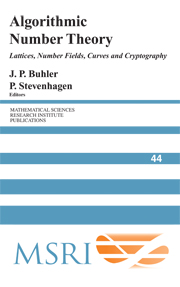Book contents
- Frontmatter
- Contents
- Preface
- Solving the Pell equation
- Basic algorithms in number theory
- Smooth numbers and the quadratic sieve
- The number field sieve
- Four primality testing algorithms
- Lattices
- Elliptic curves
- The arithmetic of number rings
- Smooth numbers: computational number theory and beyond
- Fast multiplication and its applications
- Elementary thoughts on discrete logarithms
- The impact of the number field sieve on the discrete logarithm problem in finite fields
- Reducing lattice bases to find small-height values of univariate polynomials
- Computing Arakelov class groups
- Computational class field theory
- Protecting communications against forgery
- Algorithmic theory of zeta functions over finite fields
- Counting points onvarieties over finite fields of small characteristic
- Congruent number problems and their variants
- An introduction to computing modular forms using modular symbols
Smooth numbers and the quadratic sieve
Published online by Cambridge University Press: 30 May 2025
- Frontmatter
- Contents
- Preface
- Solving the Pell equation
- Basic algorithms in number theory
- Smooth numbers and the quadratic sieve
- The number field sieve
- Four primality testing algorithms
- Lattices
- Elliptic curves
- The arithmetic of number rings
- Smooth numbers: computational number theory and beyond
- Fast multiplication and its applications
- Elementary thoughts on discrete logarithms
- The impact of the number field sieve on the discrete logarithm problem in finite fields
- Reducing lattice bases to find small-height values of univariate polynomials
- Computing Arakelov class groups
- Computational class field theory
- Protecting communications against forgery
- Algorithmic theory of zeta functions over finite fields
- Counting points onvarieties over finite fields of small characteristic
- Congruent number problems and their variants
- An introduction to computing modular forms using modular symbols
Summary
This article gives a gentle introduction to factoring large integers via the quadratic sieve algorithm. The conjectured complexity is worked out in some detail.
When faced with a large number n to factor, what do you do first? You might say, “Look at the last digit,” with the idea of cheaply pulling out possible factors of 2 and 5. Sure, and more generally, you can test for divisibility cheaply by all of the very small primes. So it may as well be assumed that the number n has no small prime factors, say below log n. Since it is also cheap to test for probable primeness, say through the strong probable prime test, and then actually prove primality as in [Schoof 2008] in the case that you become convinced n is prime, it also may as well be assumed that the number n is composite.
Trial division is a factoring method (and in the extreme, a primality test) that involves sequentially trying n for divisibility by the consecutive primes. This method was invoked above for the removal of the small prime factors of n. The only thing stopping us from continuing beyond the somewhat arbitrary cut off of log n is the enormous time that would be spent if the smallest prime factor of n is fairly large. For example, if n were a modulus being used in the RSA cryptosystem, then as current protocols dictate, n would be the product of two primes of the same order of magnitude. In this case, factoring n by trial division would take roughly n1/2 steps. This already is an enormous calculation if n has thirty decimal digits, and for numbers only slightly longer, the calculation is not possible at this time by the human race and all of their computers.
Information
- Type
- Chapter
- Information
- Algorithmic Number TheoryLattices, Number Fields, Curves and Cryptography, pp. 69 - 82Publisher: Cambridge University PressPrint publication year: 2008
Accessibility standard: Unknown
Why this information is here
This section outlines the accessibility features of this content - including support for screen readers, full keyboard navigation and high-contrast display options. This may not be relevant for you.Accessibility Information
- 1
- Cited by
